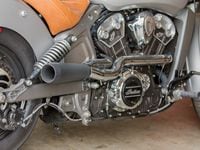WRIST: Brian Hatano
MSRP (2015): $11,299
MILES: 5,097
MPG: 43
MODS:Trask Performance exhaust, Dynojet fuel module, mandatory earplugs
UPDATE: 7
I have a pretty clear picture in my head of what I want my Indian Scout to look like. The most obvious direction would be to deck it out with all of the factory accessories, most of which are designed to convert the Scout into a minibagger and weekend two-up touring machine. But that's too easy and there are already plenty of good examples of that on the Scout forums. Probably the closest representation of what I have in mind is the Wall of Death Scout custom that has been on display at some of the International Motorcycle Shows as well as at the Scout debut at Sturgis last year. While I won't be able to incorporate some of the trick modifications or custom-fabricated parts that make the WoD Scout such a cool piece, I think that I can come up with a few aftermarket mods that will get me in the ballpark, style-wise.
I have two issues with the factory-accessory Straights slip-ons that we installed on the Scout previously. First was the power-per-dollar return. For $800 and a factory ECU reflash (included in that cost), I was expecting to see some positive numbers. Instead, we experienced a few tenths lost in the horsepower column and only a fractional gain in torque. I’ll be interested in seeing what results other Scout owners are seeing after installing the Straights slip-ons.
My second issue is that the Indian slip-ons are too OEM looking for what I have in mind. I’m pretty sure that’s exactly what they had in mind with the Straights, and not only do the pipes look like genuine original equipment, but the fit and finish is excellent. But chromed shotgun-style slip-ons just don’t fit into my plans.
One of the first exhaust systems that caught my eye was a 2-into-1 pipe from Trask Performance (traskperformance.com; $900), a company known for big twin turbo systems. The Trask 2-1 pipe for the Scout is exactly what I was looking for: blacked out with a touch of chrome and a racy design with bends that keep the pipes up high, tracker style. To extract maximum performance from the Trask pipe, I ordered a Dynojet Power Commander V, (powercommander.com; $400), which tucks in beneath the Scout seat with very little room to spare.
Prior to the Trask pipe and PCV installation, I ran another baseline with the stock pipe followed by a run with the Trask 2-1 and the fuel module loaded with a Trask-supplied map. Here are the results. Baseline: 87.7 hp at 7,800 rpm and 64.6 pound-feet of torque at 5,900 rpm. Afterward, we got 95.3 hp at 8,000 rpm and 69.2 pound-feet at 5,000 rpm.
A 7.6-hp/4.6 pound-feet bump in performance is a solid improvement, but there’s a price to pay in addition to the $1,300 investment for pipe and PCV. The Trask 2-1 is loud. Really loud. Using the SAE J2825 sound test, we got 101.1 dBa at idle and 100.5 dBa at 2,000 rpm, which are the recommended test points under no load. The specified limits laid out in this test are 92 dBa and 96 dBa, respectively. Sorry, neighbors.

















/cloudfront-us-east-1.images.arcpublishing.com/octane/QSTCM6AVEZA5JJBUXNIQ3DSOF4.jpg)
/cloudfront-us-east-1.images.arcpublishing.com/octane/U4I7G625B5DMLF2DVIJDFZVV6M.jpg)
/cloudfront-us-east-1.images.arcpublishing.com/octane/B6XD6LS6IVCQPIU6HXDJSM3FHY.jpg)
/cloudfront-us-east-1.images.arcpublishing.com/octane/ICL63FEDDRDTTMINYICCEYGMDA.jpg)
/cloudfront-us-east-1.images.arcpublishing.com/octane/FCGZHQXRBZFLBAPC5SDIQLVF4I.jpg)
/cloudfront-us-east-1.images.arcpublishing.com/octane/WNOB6LDOIFFHJKPSVIWDYUGOPM.jpg)

/cloudfront-us-east-1.images.arcpublishing.com/octane/X33NU3E525ECRHXLNUJN2FTRKI.jpg)
/cloudfront-us-east-1.images.arcpublishing.com/octane/6KKT5NNL2JAVBOXMZYS5ZO76YA.jpg)
/cloudfront-us-east-1.images.arcpublishing.com/octane/J5RKG5O455GMPGQRF2OG6LRT7A.jpg)
/cloudfront-us-east-1.images.arcpublishing.com/octane/GX2CIZKQVRH2TATDM26KFG2DAE.jpg)
/cloudfront-us-east-1.images.arcpublishing.com/octane/ZWIDYSAKQZHD5BHREMQILXJCGM.jpg)
/cloudfront-us-east-1.images.arcpublishing.com/octane/CYUHJZCTSJCH3MRAQEIKXK7SCQ.jpg)
/cloudfront-us-east-1.images.arcpublishing.com/octane/LKOFINY56FCXJCANJ5M7ZDQUBY.jpg)
/cloudfront-us-east-1.images.arcpublishing.com/octane/4NBPDACMWJH63JQYJVK3QRBDZI.jpg)
/cloudfront-us-east-1.images.arcpublishing.com/octane/KKHQHRR3FJGX7H2IPU6RALMWG4.jpg)

/cloudfront-us-east-1.images.arcpublishing.com/octane/5IOFS5JAE5FOXMNA23ZRAVVYUU.jpg)
/cloudfront-us-east-1.images.arcpublishing.com/octane/CGXQ3O2VVJF7PGTYR3QICTLDLM.jpg)

/cloudfront-us-east-1.images.arcpublishing.com/octane/OQVCJOABCFC5NBEF2KIGRCV3XA.jpg)
/cloudfront-us-east-1.images.arcpublishing.com/octane/OPVQ7R4EFNCLRDPSQT4FBZCS2A.jpg)
/cloudfront-us-east-1.images.arcpublishing.com/octane/YBPFZBTAS5FJJBKOWC57QGEFDM.jpg)
/cloudfront-us-east-1.images.arcpublishing.com/octane/W5DVCJVUQVHZTN2DNYLI2UYW5U.jpg)